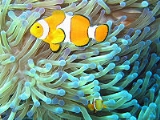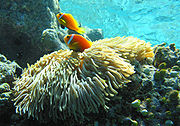
Heteractis magnifica
Encyclopedia
Heteractis magnifica, also known by the common name
s magnificent sea anemone or Ritteri anemone, is a species of sea anemone
that lives in the Indo-Pacific
area, and can grow up to 1 metre (3 feet) in diameter
in the wild. It can be kept in aquaria but is considered one of the most challenging species to keep healthy. They require very strong lighting and very high chaotic flow. They will not survive in tanks with any presence of nitrites or nitrates. If they are healthy and kept well fed they will grow very rapidly. H. magnifica consumes both vertebrate
s and invertebrate
s, including fish and crustacean
s.
 It is often found in association with anemonefish, or clownfish
It is often found in association with anemonefish, or clownfish
, such as the cinnamon anemonefish (Amphiprion melanopus
), Clark's anemonefish (A. clarkii), common clownfish (A. ocellaris), blackfinned anemonefish (A. nigripes
), true clownfish (A. percula), and the pink skunk clownfish (A. perideraion
). Juvenile
Threespot dascyllus (Dascyllus trimaculatus
) also commonly associate with this sea anemone.
H. magnifica was featured in the Pixar
Animations film Finding Nemo
.
Common name
A common name of a taxon or organism is a name in general use within a community; it is often contrasted with the scientific name for the same organism...
s magnificent sea anemone or Ritteri anemone, is a species of sea anemone
Sea anemone
Sea anemones are a group of water-dwelling, predatory animals of the order Actiniaria; they are named after the anemone, a terrestrial flower. Sea anemones are classified in the phylum Cnidaria, class Anthozoa, subclass Zoantharia. Anthozoa often have large polyps that allow for digestion of larger...
that lives in the Indo-Pacific
Indo-Pacific
The Indo-Pacific is a biogeographic region of the Earth's seas, comprising the tropical waters of the Indian Ocean, the western and central Pacific Ocean, and the seas connecting the two in the general area of Indonesia...
area, and can grow up to 1 metre (3 feet) in diameter
Diameter
In geometry, a diameter of a circle is any straight line segment that passes through the center of the circle and whose endpoints are on the circle. The diameters are the longest chords of the circle...
in the wild. It can be kept in aquaria but is considered one of the most challenging species to keep healthy. They require very strong lighting and very high chaotic flow. They will not survive in tanks with any presence of nitrites or nitrates. If they are healthy and kept well fed they will grow very rapidly. H. magnifica consumes both vertebrate
Vertebrate
Vertebrates are animals that are members of the subphylum Vertebrata . Vertebrates are the largest group of chordates, with currently about 58,000 species described. Vertebrates include the jawless fishes, bony fishes, sharks and rays, amphibians, reptiles, mammals, and birds...
s and invertebrate
Invertebrate
An invertebrate is an animal without a backbone. The group includes 97% of all animal species – all animals except those in the chordate subphylum Vertebrata .Invertebrates form a paraphyletic group...
s, including fish and crustacean
Crustacean
Crustaceans form a very large group of arthropods, usually treated as a subphylum, which includes such familiar animals as crabs, lobsters, crayfish, shrimp, krill and barnacles. The 50,000 described species range in size from Stygotantulus stocki at , to the Japanese spider crab with a leg span...
s.

Clownfish
Clownfish or anemonefish are fishes from the subfamily Amphiprioninae in the family Pomacentridae. Twenty-eight species are recognized, one in the genus Premnas, while the remaining are in the genus Amphiprion. In the wild they all form symbiotic mutualisms with sea anemones...
, such as the cinnamon anemonefish (Amphiprion melanopus
Cinnamon Clownfish
Cinnamon clownfish or fire clownfish is a widely distributed clownfish. It is found in Indonesia, Melanesia, Micronesia, southeastern Polynesia, and the Great Barrier Reef....
), Clark's anemonefish (A. clarkii), common clownfish (A. ocellaris), blackfinned anemonefish (A. nigripes
Amphiprion nigripes
Amphiprion nigripes, also known as the Blackfinned anemonefish or Maldives anemonefish, is a clownfish of the genus Amphiprion. -Description:...
), true clownfish (A. percula), and the pink skunk clownfish (A. perideraion
Pink skunk clownfish
The pink skunk clownfish or pink anemonefish, Amphiprion perideraion, is a skunk clownfish found in the west Pacific Ocean. It is known to be one of the smaller clownfish. They can be found off the Cocos and Christmas Islands in the eastern Indian Ocean, and the Indo-Australian...
). Juvenile
Juvenile (organism)
A juvenile is an individual organism that has not yet reached its adult form, sexual maturity or size. Juveniles sometimes look very different from the adult form, particularly in terms of their colour...
Threespot dascyllus (Dascyllus trimaculatus
Threespot dascyllus
The Threespot dascyllus , also known as the Domino Damsel or simply Domino, is a species of damselfish from the family Pomacentridae...
) also commonly associate with this sea anemone.
H. magnifica was featured in the Pixar
Pixar
Pixar Animation Studios, pronounced , is an American computer animation film studio based in Emeryville, California. The studio has earned 26 Academy Awards, seven Golden Globes, and three Grammy Awards, among many other awards and acknowledgments. Its films have made over $6.3 billion worldwide...
Animations film Finding Nemo
Finding Nemo
Finding Nemo is a 2003 American comi-drama animated film written by Andrew Stanton, directed by Andrew Stanton and Lee Unkrich and produced by Pixar. It tells the story of the overly protective clownfish Marlin who, along with a regal tang called Dory , searches for his abducted son Nemo...
.

